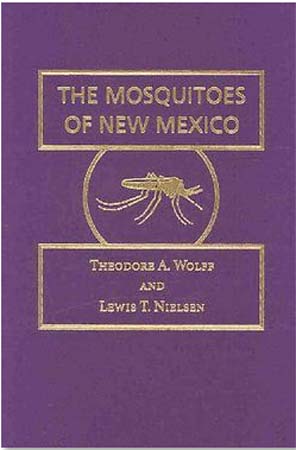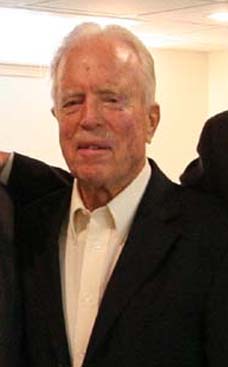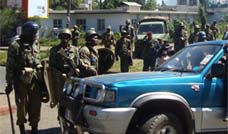
Wolff is not a recent arrival to New Mexico. He’s worked as a science teacher, served in the Peace Corps abroad, and worked for the New Mexico Health Department in medical parasitology. It was there that he had many occasions to collect mosquitoes over the entire state. The Mosquitoes of New Mexico is an epic collection of everything you ever wanted to know about where the 60 species of mosquitoes live and how they make a living. It is a handsome book; the title and a mosquito are embossed in gold on a cover of purple — like the blood that courses through veins that female mosquitoes need to procreate. New Mexico is blessed with an extreme diversity of land types, Wolff says. Near Las Cruces you’ll find Chihuahuan grasslands. Near Taos you’ll find alpine tundra. At both ends, and in between, you’ll find a diversity of habitats, and that diversity is expressed in the tiny mosquitoes that live there. Between the pages of Wolff and Nielsen’s book you’ll read that not all mosquitoes are pests; they pollinate flowers and have their place in nature, they themselves feeding bats and barn swallows and flycatchers.
Malaysia RPCV Theodore Wolff writes "The Mosquitoes of New Mexico"
OUTDOORS: New book explores secret lives of mosquitoes
Bookcover for 'The Mosquitoes of New Mexico' by Theodore A. Wolf and Lewis T. Nielson
By CRAIG SPRINGER | For The New Mexican
August 22, 2007
They are the bane and a bother for any outdoorsman. Foul weather aside, biting bugs can blight a good outing. And the tiniest of biting bugs, mosquitoes, can kill you.
Probably no other animal on the face of the Earth has been responsible for more deaths, so says Theodore Wolff, PhD, a co-author of a new book from The University of New Mexico Press, titled The Mosquitoes of New Mexico. Wolff co-wrote the book with Lewis T. Nielsen, emeritus professor of entomology at the University of Utah. Millions of people have died from a tiny prick of the skin by a mosquito.
We outdoorspeople go to great length to keep mosquitoes at length: netting, salves and sprays, even new clothing is on the market and stitched in its fabric is bug repellent. It’s an age-old problem for anyone spending time out of doors for whatever reasons. The names we put on places document our experiences in an autobiographical sense: Witness the town of Mosquero in Harding County — it loosely means “swarm of flies,” undoubtedly documenting someone’s unpleasant experience along a creek of the same name.
Lewis and Clark’s Corps of Discovery discovered mosquitoes were an epic problem. But Lewis came prepared, provisioning the Corps with netting and a catgut, tallow and hog lard salve to serve as repellent. But one senses the salves didn’t work. Lewis wrote once that mosquitoes were so thick in his face and on his rifle, that he couldn’t see his front sight to aim. The writers wrote variously that the “musquetors were most troublesome.”
And it’s the trouble that they bring that was the impetus to write an arcane book on the natural history of New Mexico. Wolff, who works in community outreach at Sandia National Laboratory, has had an interest in these little disease vectors since childhood. Growing up in Philadelphia, Wolff was keenly aware of a historic event that nearly brought the young United States to its knees in 1793. It wasn’t a foreign invading army, but mosquitoes.
Yellow fever broke out in the then capital city of the United States. Those who could leave did, like President George Washington. But Stephen Girard stayed, aiding the sick. Girard Street in Albuquerque is named for this philanthropist and the college he founded and Wolff attended.
Wolff is not a recent arrival to New Mexico. He’s worked as a science teacher, served in the Peace Corps abroad, and worked for the New Mexico Health Department in medical parasitology. It was there that he had many occasions to collect mosquitoes over the entire state.
The Mosquitoes of New Mexico is an epic collection of everything you ever wanted to know about where the 60 species of mosquitoes live and how they make a living. It is a handsome book; the title and a mosquito are embossed in gold on a cover of purple — like the blood that courses through veins that female mosquitoes need to procreate.
New Mexico is blessed with an extreme diversity of land types, Wolff says. Near Las Cruces you’ll find Chihuahuan grasslands. Near Taos you’ll find alpine tundra. At both ends, and in between, you’ll find a diversity of habitats, and that diversity is expressed in the tiny mosquitoes that live there.
Some lay eggs in holes in trees, some in desert rocks. Others live only the briefest time to lay eggs in snow-melt pools at 12,000 feet.
Between the pages of Wolff and Nielsen’s book you’ll read that not all mosquitoes are pests; they pollinate flowers and have their place in nature, they themselves feeding bats and barn swallows and flycatchers.
You might sense, too, the dedication and attachment that scientists have to their subject of study. One species common to the Gila region, Anopheles judithae, was named for the wife of the man who described it for science. They don’t have common names, but this one might be called Judith’s mosquito.
Another known at Uranotaenia sapphirina is so named for a sapphire-like quality in its coloration. It’s confined to northeastern New Mexico and may have been the “mosquero” that so impressed at least one writer who laid the name to a place.
This book, profusely illustrated with detailed drawings, will undoubtedly be put to good use by scientists and mosquito-control workers. And for anyone interested in the natural history of New Mexico, it belongs on your bookshelf, too.
[Get Copyright Permissions] Click here for copyright permissions!
Copyright 2007 The New Mexican, Inc.









